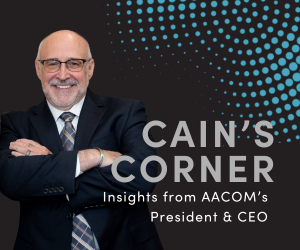Reclaiming Osteopathic Interconnectedness
Published July 16, 2025
By Robert A. Cain, DO
Cains Corner
A Profession Rooted in Connection
As osteopathic medical educators, we teach our students to recognize the important connections between body, mind and spirit. This is the heart of osteopathic philosophy. We understand that structure and function are inherently linked—and that systems work best when they are coordinated and integrated.
This same principle of interconnectedness has guided our approach to osteopathic medical education as well. While single accreditation achieved certain critical goals—like expanding access to residency for colleges of osteopathic medicine graduates and improving efficiency by integrating two separate accreditation systems to benefit health systems that were operating both DO and MD residencies—it also changed the dynamics of connection and feedback within osteopathic medical education.
A Changing System of Connection
Before the transition to a single system of graduate medical education (GME) accreditation, our continuum of education—from undergraduate medical education (UME) into continuing medical education (CME)—was far from perfect. But it was highly interconnected.
Because of our Osteopathic Postdoctoral Training Institutions (OPTI) model, GME previously served as a dynamic hub, linking the medical school classroom to clinical practice and the faculty bench to the patient bedside—for students, residents and fellows alike. It helped create feedback loops that supported shared learning, research, innovation and professional development. Even amid professional disagreement, we remained in dialogue across the three phases of medical education.
As osteopathic GME’s structural role diminished during the single accreditation transition, many of the rituals, routines and relationships that once connected UME, GME and CME began to fade. Today, the remaining UME and GME phases are more likely to function in silos than in partnership. With fewer shared venues and less feedback loops, our collective ability to evolve, respond and lead change has diminished.
.png?sfvrsn=782fbd39_3)
Why Interconnectedness Still Matters
In osteopathic medicine, we believe that structure and function are interdependent. That insight applies as much to our systems of education as it does to anatomy and physiology.
When the UME—GME—CME continuum existed:
- Opportunities for innovation were greater and implementation could be more rapid and scalable
- Challenges such as training gaps or learner support needs could be identified and addressed earlier
- Differences became productive tensions rather than divisive obstacles
- Our model both created community and connected us to the communities where training occurred
Losing the continuum created fragmentation and slowed evolution and responsiveness at a time when the profession is experiencing extraordinary growth—and should be poised to positively impact the healthcare system through our philosophy and approach to practicing medicine.
Why This Matters—Now More Than Ever
The U.S. healthcare system is at a crossroads and in urgent need of models that prioritize:
- Whole-person, relationship-centered care
- Community-based prevention and solutions
- A workforce responsive to local and national needs
These are osteopathic strengths. But to lead in this moment, our educational structures must reflect the principles we champion in patient care: integration, coordination and responsiveness.
To put it plainly, we need to create new ways to connect so that we can enhance our ability to grow, respond and lead together.
The Way Forward: Rebuilding with Purpose
At AACOM, we are working to rebuild and modernize the connections across the continuum of osteopathic medical education. That means:
- Reimagining Educating Leaders as a dynamic hub for cross-continuum dialogue
- Elevating the voices of faculty leaders, clinical educators and program directors to reduce silos and enhance collaboration
- Reviving the value of shared rituals, convenings and forums that sustain our professional culture
- Launching initiatives with partners across the osteopathic family that bring together UME, GME and CME voices to spark innovation
But we cannot do this alone. A shared commitment across institutions, individuals and organizations is needed—not just in spirit, but in the very architecture of how we teach, train and support the next generation of osteopathic physicians.
The Call: Let’s Reconnect
We must create opportunities to convene as a community and focus on building an educational ecosystem that is:
- Coordinated without being uniform
- Diverse without being divided
- Collaborative even in the face of disagreement
Interconnectedness isn’t just an osteopathic principle—it is a professional imperative for meeting the challenges of today and shaping the healthcare system of the future that our communities deserve.
Let’s reconnect—with purpose—and move forward together to make a difference for society during this challenging period in medicine.

